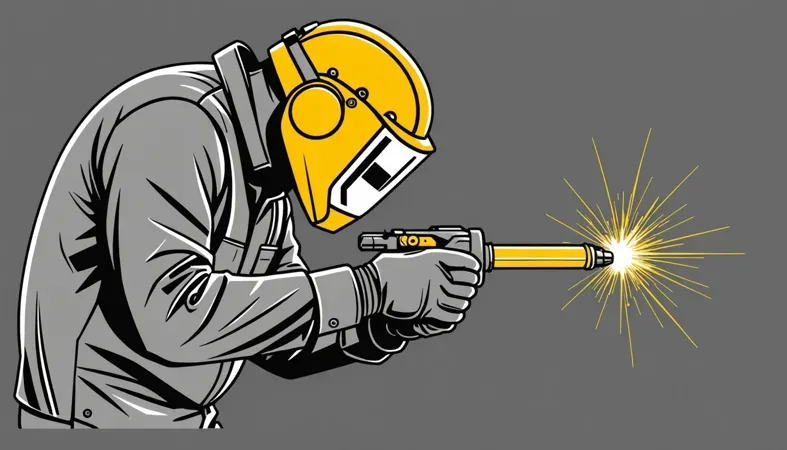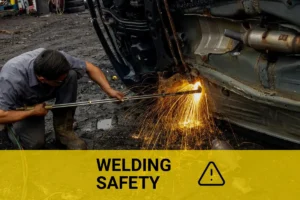How to Weld a Nut to a Broken Bolt? Tips, Steps, and Precautions
Published on: April 19, 2025 | Last modified: March 4, 2025
By: Joe Carter
A broken bolt is simply a bolt that’s snapped or fractured, making it impossible to use. This can lead to frustrating repair headaches for you.
It’s a question I’ve heard often: how to weld a nut to a broken bolt. Knowing how to weld a nut onto a broken bolt is crucial, especially in tight situations. I’ve dealt with this myself, and it just saves time and money compared to replacing the whole bolt.
In this guide, I’m covering what a broken bolt is, types of broken bolts, items needed, steps for welding a nut on a broken bolt, necessary precautions, types of welding techniques, factors that influence the weld, potential issues, aftercare, the benefits of this method, and even alternatives. If you want to know more, stick around as we delve into how to weld a broken bolt successfully.
Contents
- How to Weld A Nut to A Broken Bolt?
- What is a Broken Bolt?
- Types Of Broken Bolts
- Things You’ll Need
- Steps to Weld a Nut to a Broken Bolt
- Precautions
- Types Of Welding for Nuts on Broken Bolts
- Factors Affecting Welding a Nut to a Broken Bolt
- What Could Go Wrong: Unique Issues With a Broken Bolt
- Aftercare, Inspection, and Advanced Tips for Welding a Nut to a Broken Bolt
- Common Mistakes When Welding a Nut to a Broken Bolt
- Advantages Of Welding a Nut to a Broken Bolt
- Where is Welding a Nut to a Broken Bolt Used?
- Alternatives for Welding a Nut to a Broken Bolt
- Frequently Asked Questions (FAQs)
- Conclusion
- Additional Reading
How to Weld A Nut to A Broken Bolt?
A broken bolt, simply put, is a bolt that snaps. To weld a nut onto a broken bolt, clean the area, then heat it and fuse a nut using 250-300 amps. This task can be tricky and suits experienced welders.
What is a Broken Bolt?
A broken bolt is one that fails under stress, often snapping cleanly or fracturing. These failures usually happen due to excessive force, fatigue, or corrosion. About 30% of mechanical failures in machinery are due to broken fasteners. Common bolt sizes range from M6 (6mm or 1/4 Inch) to M30 (30mm or 1 Inch) in diameter. Materials typically include steel, aluminum, and titanium.
Many people wonder how to weld a nut to a broken bolt. I’ve tried this method a few times, and it can save you time and money. If done correctly, welding a nut securely onto the remaining bolt allows for easy extraction.
I found this technique useful when I needed to repair a broken exhaust bolt on an aluminum head. I quickly learned that knowing how to remove a broken bolt can make all the difference. Without proper techniques, like good heat control and cleanliness, you might end up with bigger issues, such as how to break a welded bolt. Trust me, investing time to learn these skills pays off!
Types Of Broken Bolts
What types of broken bolts might you encounter?
-
Sheared Bolts
Sheared bolts break due to excessive force or pressure. To fix this, weld a nut onto the remaining bolt stub. Start by cleaning the area with a wire brush and ensure good metal contact when positioning a matching nut on top.
-
Corroded Bolts
Corroded bolts often break because rust weakens them over time. To weld a nut, clean off any rust with a wire brush or grinder. Apply heat to the nut using a torch before welding to help penetrate the corrosion and enhance the bond.
-
Over-torqued Bolts
Over-torqued bolts can fracture when too much torque is applied during installation. If this occurs, weld a high-quality nut onto the broken piece after cleaning it and applying heat during the welding process.
-
Threaded Bolts
Threaded bolts break such that part of the thread remains in the host material. For these bolts, weld the nut directly onto the unthreaded section after using a tap to clean out the threads. Choose a robust MIG welder for maximum effectiveness.
-
Stuck Bolts
Stuck bolts don’t necessarily break but fail to turn. If one snaps off, weld a nut onto the visible part after cleaning any debris. Heat it slightly, then firmly apply your weld to secure it before attempting to turn it.
We’ve wrapped up the types of broken bolts here. Next up, we’ll look at the necessary items you’ll need.
Things You’ll Need
What do you need to weld a nut to a broken bolt?
- MIG Welder: You’ll need a MIG welder, such as the Lincoln Electric Handy MIG (K2497-FAC). It helps you weld quickly and efficiently.
- Welding Wire: You’ll need ER70S-6 welding wire, preferably 0.030 in (0.76 Mm) in diameter. It’s excellent for thin materials and provides a strong bond.
- Arc Welding Electrode: Use 6013 electrodes like the Hobart 6013 (3/32 in). They ensure a smooth arc and reliable penetration.
- Anti-Spatter Spray: Get Wolfride Anti-Spatter Spray. It keeps your work area clean and enhances visibility.
We’ve wrapped up the necessary materials here. Next up, we’ll look at the process for welding a nut to a broken bolt.
Steps to Weld a Nut to a Broken Bolt
Here are the steps to successfully weld a nut onto a broken bolt. Follow them closely for the best results.
-
Prepare the Workspace
Clear your workspace of debris and obstacles. Ensure you have a flat surface for stability. Good lighting helps you see clearly, especially in tight areas. Avoid distractions when dealing with high heat and sparks!
-
Choose the Right Nut
Select a nut that matches the broken bolt’s diameter. For example, if your broken bolt is 10 mm (0.39 Inches) in diameter, use a corresponding metric nut. Using the wrong size can lead to a poor bond and limit your repair options. This ensures a tight connection after welding.
-
Clean the Broken Bolt
Brush and clean the broken bolt with a wire brush or grinder. This step is crucial because rust, dirt, or oil can disrupt the weld. Expose clean metal for a solid bond. A clean area enhances heat transfer, helping the nut adhere better.
-
Align the Nut on the Bolt
Position the nut directly over the top of the broken bolt and hold it in place with clamps if necessary. Perfect alignment is essential since misalignment can lead to uneven welds. A mistake here could waste your time!
-
Weld the Nut to the Bolt
Using a MIG welder, set the appropriate voltage and speed for your material. Aim for 100-130 amps for mild steel, adjusting for thickness. Apply short, controlled welds to avoid overheating. Keep a steady hand to create even, consistent welds on all sides of the nut. When selecting electrodes like 1/8″ 7018 welding rods it can be helpful to understand how many rods are in a pound.
-
Allow to Cool
Let the welded nut cool at room temperature. Rapid cooling can cause cracks. Wait at least 10-15 minutes before handling the welded joint. This cooling phase is vital for maintaining the strength of your weld. A bit of patience goes a long way!
-
Test the Welded Joint
Use a wrench to gently test the welded nut. Ensure it holds solidly against twisting forces. If the weld holds up, you’ve successfully repaired your broken bolt! If there are any signs of weakness, redo the weld. It’s better to check twice before moving ahead.
That covers the process of welding a nut to a broken bolt. Let’s now take a look at safety measures.

Precautions
Here are crucial safety tips for welding a nut to a broken bolt.
- Wear Protective Gear: Use safety glasses and welding gloves to shield against sparks. I recommend Miller’s welding gloves for the best protection.
- Ventilate the Area: Ensure good airflow to remove harmful fumes. Aim for at least 100 CFM (Cubic Feet Per Minute) of ventilation.
- Ground Your Equipment: Proper grounding reduces the risk of electric shock. Use ground cables rated for at least 4 AWG.
- Check for Flammable Materials: Remove any flammable debris from your workspace to prevent fires, especially in tight spots.
Taking these safety precautions is essential—it keeps everything running smoothly and you safe.
We covered safety measures and essential tips here. Next, we will cover different welding methods for nuts on broken bolts.
Types Of Welding for Nuts on Broken Bolts
Let’s explore different welding methods: MIG, TIG, Arc, Spot, and Resistance welding.
-
MIG Welding
MIG (Metal Inert Gas) welding uses a continuous wire feed and an inert gas, typically argon or CO2, for shielding. It’s efficient for welding nuts onto broken bolts because it’s fast and provides good penetration. It’s ideal for thicknesses from 1.5 mm (1/16 Inch) to 12.7 mm (1/2 Inch), helping you save time on stubborn bolts. Understanding the types and costs of welding rods can enhance the efficiency of such tasks.
-
TIG Welding
TIG (Tungsten Inert Gas) welding offers precise control, making it perfect for delicate tasks like welding a nut onto a broken bolt. You can use AC for aluminum or DC for steel, with the weld pool’s depth easily manageable. This method is particularly effective for thinner materials or tricky angles, typically up to 6 mm (1/4 Inch) thick. Understanding welding fundamentals can greatly enhance your skills in TIG welding.
It’s important to note that power requirements can vary, and you might wonder how many amps a welder uses for such tasks.
-
Arc Welding
Arc welding is versatile and uses an electric arc to melt the metals being joined. It’s ideal for quickly fixing robust structures or large bolts, making it an effective choice for various welding projects. This method works best for materials over 3 mm (1/8 Inch) thick, so it may not suit all broken bolt applications; for additional insights, you might want to consider the available welding guidance.
Identifying the characteristics of an excellent weld is crucial to ensuring safety and integrity in the arc welding process. For more information on what constitutes a good weld, you can delve deeper into expert assessments.
-
Spot Welding
Spot welding involves pressing the metal together and applying heat at specific points. It’s efficient for joining steels and is commonly used in automotive applications. While it works well on thin materials, it’s not always the best choice for heavier nuts on larger broken bolts.
-
Resistance Welding
Resistance welding generates heat through electric current flow between workpieces. It’s a strong option for fast and durable fixes without melting adjacent metal. For nuts on broken bolts, this method is typically limited to thinner sections, making it less common. Gas mixtures play a significant role in welding processes, including tri mix welding gas applications.
Factors Affecting Welding a Nut to a Broken Bolt
What factors influence welding a nut onto a damaged bolt? Let’s break it down.
-
Material Of the Bolt
The material type affects weldability. Common materials include steel, stainless steel, and aluminum, with melting points ranging from 660 °C (1220 °F) for aluminum to 1370 °C (2500 °F) for high-carbon steel.
-
Weld Penetration Depth
Optimal penetration ensures a strong weld. Aim for at least 2-3 mm (0.08-0.12 In) for a solid bond, but excessive depth can weaken the structure.
-
Welding Temperature
Temperature is crucial during welding. Ideal temperatures range from 1000 °C to 1300 °C (1832 °F to 2372 °F) to prevent brittleness in the weld pool.
-
Type Of Welding Technique
MIG, TIG, and Stick welding each affect the outcome. For instance, MIG welding provides smoother finishes but is sensitive to outdoor conditions due to wind interference.
-
Thickness Of the Nut
Thicker nuts absorb more heat and provide better support. Opt for nuts at least 5 mm (0.2 In) thick for durability when attached.
What Could Go Wrong: Unique Issues With a Broken Bolt
Here’s a look at specific problems you may face with a broken bolt.
-
Poor Weld Strength
A weak weld on a broken bolt can lead to re-breaks. Check the bond with tests like a tensile strength test—aim for a minimum of 30,000 psi (207 Mpa). To fix this, grind the area and try re-welding with a stronger filler material. Proper storage and handling of welding rods also play a crucial role in achieving robust welds, aiding significantly in how to store welding rods.
-
Misalignment Of the Nut
The broken bolt may misalign if you don’t position the nut correctly. Proper alignment is crucial. Use a jig to ensure the nut is seated correctly before welding. If it’s misaligned, re-position and grind cleanly before re-welding.
-
Excessive Heat Damage
High heat can weaken the broken bolt. Check for discoloration or warping. To solve this, use the MIG (Metal Inert Gas) technique instead of TIG (Tungsten Inert Gas) for better heat control, focusing only on the bolt area to minimize broader damage.
-
Incomplete Weld Penetration
Welds on a broken bolt may remain on the surface without reaching deeper. Use a 5 mm (1/4 in) diameter rod to enhance penetration depth. Grind to clean the bolt and use lower settings to prevent shallow welds during welding.
Getting familiar with the intricacies of using advanced tools can further improve welding outcomes. For instance, you might explore the benefits of a DC inverter welding machine to achieve precise and efficient welds.
-
Overheating Of Surrounding Areas
Overheating affects surrounding materials when working on a broken bolt. Look for discoloration in the base metal. To manage this, use intermittent welding to allow cooling or employ a heat sink to absorb some heat.
Aftercare, Inspection, and Advanced Tips for Welding a Nut to a Broken Bolt
Here are some essential aftercare, inspection steps, and expert advice to refine your welding skills on broken bolts.
Aftercare Suggestions
After welding a bolt, cool it slowly. Quenching in oil can cause cracks, so let it air cool to prevent stress. Finally, clean the welded joint with a wire brush for better performance.
Inspection Steps
Start the inspection by visually assessing the weld joint for gaps or imperfections. Use dye penetrant inspection, like Raytech DT-120 spray, to reveal defects. I’ve used this system, and it’s reliable; your weld must pass inspection before reinstallation. Understanding the function of a backing strip can significantly enhance weld quality, as it provides crucial support and contributes to a sound weld structure, making its purpose in welding an important topic to consider for optimal results.
Expert Tips
Use preheating techniques on larger bolts—aim for about 150°C (302°F) to prevent warping during welding. Choose a 309 stainless steel filler rod for better ductility; my projects showed higher strength compared to standard rods. Finally, ensure your polarity is set to reverse for optimal penetration.
Common Mistakes When Welding a Nut to a Broken Bolt
Even pro welders run into issues. Here are some common mistakes you should watch out for.
| Mistake | Description | How to Avoid |
|---|---|---|
| Using the Wrong Nut Size | A nut that’s too big or small won’t fit right on the bolt. | Always measure the diameter of the broken bolt first. Use an appropriate nut size, ideally matching the bolt’s diameter. |
| Poor Preparation | Not cleaning the surface can weaken the weld. | Clean the broken bolt thoroughly. Use a wire brush or grinder to ensure contact with clean metal. |
| Mismatched Welding Technique | Using a technique that doesn’t suit the materials can lead to weak connections. | Choose MIG for speed or TIG for control, based on your specific needs. Know your materials. |
| Ignoring Cooling Time | Quick cooling can cause cracks in the weld. | Let the welded assembly cool naturally. Avoid quenching for a stronger bond. |
| Skipping Testing | Not checking the strength of your weld can lead to failure. | Always test the weld strength with a wrench. Look for any signs of weakness before moving forward. |
Advantages Of Welding a Nut to a Broken Bolt
The main advantage of welding a nut to a broken bolt is the ability to extract damaged bolts without drilling. I found this method useful when I had to fix a stubborn bolt that wouldn’t budge.
Additionally, it can save time and effort, reduce costs on replacements, keep your equipment operational, and minimize the risk of further damage during extraction.
Where is Welding a Nut to a Broken Bolt Used?
People use this technique to fix machinery, but it has many applications, including:
- Agricultural Equipment Repairs: This method works well on broken bolts in farming machinery. It saves time and keeps equipment running efficiently.
- Automotive Repair: Car enthusiasts often weld nuts to broken bolts stuck in engine blocks. It’s a reliable way to extract stubborn bolts without damaging the block.
- Machinery Maintenance: Workshops use this technique to repair broken bolts on conveyor belts. The strong weld ensures operational efficiency with less downtime.
- Construction Jobs: Welders attach nuts to broken bolts in steel structures. It’s popular because it restores integrity to essential load-bearing components.

Alternatives for Welding a Nut to a Broken Bolt
There are several options to consider if you want to tackle a broken bolt without welding. Products like a bolt remover or extractor, such as the Irwin Hanson Bolt Extractor, can save you the hassle. Alternatively, consider using high-strength adhesives like JB Weld for solid bonding in less demanding situations.
I’ve also found that if the bolt is still partially intact, careful drilling and tapping for a new thread works wonders. This method can often preserve the surrounding material, especially in sensitive areas like aluminum heads. Remember, which method to choose depends on your specific situation and toolkit.
Frequently Asked Questions (FAQs)
Here are some common questions I typically get asked about working with broken bolts and welding techniques.
Can You Weld a Nut to a Broken Bolt?
Yes, you can weld a nut to a broken bolt. This process helps you to grip the broken piece securely. Using a MIG welder, set to the right voltage and wire speed, ensures solid penetration into the metal, providing a reliable connection.
What Kind Of Weld Do You Use for Weld Nuts?
You typically use a TIG or MIG weld for welding nuts. MIG welding works faster, while TIG welds offer more control over fine details. Most weld nuts require a standard MIG setup, running around 25-35 amps, to achieve optimum weld penetration.
What Welder is Best for Broken Bolts?
The best welder for broken bolts is often a MIG welder. It allows for easy operation and quick setup. You’ll appreciate the adjustable settings, which range from 30 to 200 amps, catering to various bolt thicknesses. When delving into welding techniques, it’s crucial to understand concepts like DCEP in welding.
How to Extract a Snapped Bolt?
You can extract a snapped bolt using a specialized extraction tool or a left-hand drill bit. These tools apply counterclockwise rotation, helping to pull the broken bolt out effectively. Applying penetrating oil for 10-15 minutes prior can make the extraction much easier.
Can You Jb Weld a Broken Bolt?
Yes, you can JB Weld a broken bolt if the application isn’t under high stress. This epoxy can withstand up to 3000 PSI (207 Bar). However, for structural integrity, mechanical methods like welding are usually more reliable for fixing broken bolts.
How to Fix a Broken Weld Nut?
To fix a broken weld nut, grind away the damaged area and re-weld it using a MIG or TIG welder. Ensure surfaces are clean, and apply a complementary filler material for best adhesion, achieving a robust connection.
How to Weld a Broken Gear Tooth?
Welding a broken gear tooth involves using a TIG welder with a filler rod made of the same material as the gear. Ensure the tooth is grounded well and preheated to about 150°C (302°F) for better fusion and strength.
How to Weld a Nut on a Broken Stud?
You can weld a nut onto a broken stud effectively by using a MIG or TIG welder. Focus on even heat distribution, which helps in preventing thermal shock. Ensure the stud is clean and free of debris before starting the weld.
Conclusion
We covered what a broken bolt is, types of broken bolts, and things you’ll need, like a welding machine, nut, and protective gear. We also discussed the steps to weld a nut to a broken bolt, precautions, types of welding methods, factors that affect your success, and what could go wrong. Finally, we mentioned aftercare, advantages, where this method is used, and some alternatives.
To weld a nut to a broken bolt, make sure you’re prepared with the right tools and techniques. Start by cleaning the broken bolt, then place the nut over it and weld around the base securely. Contact me if you’d like more guidance on how to effectively execute the steps, like identifying the correct type of welding or ensuring safety measures.
To expand your knowledge on welding and explore additional resources, feel free to check out our homepage: What is Welding
Additional Reading
- American Welding Society. (2015). AWS D1.1/D1.1M: Structural Welding Code – Steel. Miami, FL: AWS.
- Weisman, J. (2011). Practical Welding Technology. Boca Raton, FL: CRC Press.
Joe Carter is a retired welding professional with over 40 years of hands-on experience in the industry, spanning ship repair, structural welding, and even underwater projects. Joe is a master of MIG, TIG, and Stick welding. Passionate about mentoring the next generation of welders, Joe now shares his decades of expertise and practical insights to help others build rewarding careers in welding.
American Welding Society, Broken Bolts, MIG Welding, Nut Welding, Repair Techniques, Safety Tips, Welding, Welding Safety, Welding Techniques, Welding Wire







